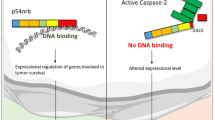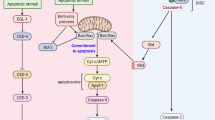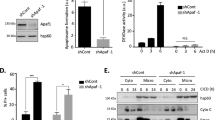Abstract
On the basis of evidences that caspase-2 gene targeting in several generated mouse models accelerates tumor formation, this enzyme was recently implicated in tumor suppression. The observed function, however, compels other molecular perturbations harboring tumorigenic properties. Therefore, the question remains as to whether or not caspase-2 can be considered a true tumor suppressor? The traditional view of caspase-2 being vital for the apoptotic response to induced cell stress in some systems is in line with these findings. Yet, caspase-2 has also been associated with other processes which equally might interfere with tumorigenic potential, including the oxidative stress response, aging and genome surveillance. By different mechanisms, this enzyme has been proposed to function as a checkpoint regulator in the cell cycle. Together, these data indicate that caspase-2 is a highly versatile factor, a view that is contrasted by the alternative explanation where the enzyme harbors a mechanism affecting a discrete process, which in turn is functionally connected to other cell systems. In any case, it is clear that the general view of caspase-2 as a protein mainly involved in apoptotic cell death is shattered. Hence, we wish to discuss the perspectives of recent achievements in caspase-2-related research.
This is a preview of subscription content, access via your institution
Access options
Subscribe to this journal
Receive 50 print issues and online access
$259.00 per year
only $5.18 per issue
Buy this article
- Purchase on Springer Link
- Instant access to full article PDF
Prices may be subject to local taxes which are calculated during checkout


Similar content being viewed by others
References
Tinel A, Tschopp J . The PIDDosome, a protein complex implicated in activation of caspase-2 in response to genotoxic stress. Science 2004; 304: 843–846.
Bouchier-Hayes L, Oberst A, McStay GP, Connell S, Tait SW, Dillon CP et al. Characterization of cytoplasmic caspase-2 activation by induced proximity. Mol Cell 2009; 35: 830–840.
Manzl C, Krumschnabel G, Bock F, Sohm B, Labi V, Baumgartner F et al. Caspase-2 activation in the absence of PIDDosome formation. J Cell Biol 2009; 185: 291–303.
Berube C, Boucher LM, Ma W, Wakeham A, Salmena L, Hakem R et al. Apoptosis caused by p53-induced protein with death domain (PIDD) depends on the death adapter protein RAIDD. Proc Natl Acad Sci USA 2005; 102: 14314–14320.
Bergeron L, Perez GI, Macdonald G, Shi L, Sun Y, Jurisicova A et al. Defects in regulation of apoptosis in caspase-2-deficient mice. Genes Dev 1998; 12: 1304–1314.
O’Reilly LA, Ekert P, Harvey N, Marsden V, Cullen L, Vaux DL et al. Caspase-2 is not required for thymocyte or neuronal apoptosis even though cleavage of caspase-2 is dependent on both Apaf-1 and caspase-9. Cell Death Differ 2002; 9: 832–841.
Ho LH, Taylor R, Dorstyn L, Cakouros D, Bouillet P, Kumar S . A tumor suppressor function for caspase-2. Proc Natl Acad Sci USA 2009; 106: 5336–5341.
Manzl C, Peintner L, Krumschnabel G, Bock F, Labi V, Drach M et al. PIDDosome-independent tumor suppression by Caspase-2. Cell Death Differ 2012; 19: 1722–1732.
Parsons MJ, McCormick L, Janke L, Howard A, Bouchier-Hayes L, Green DR . Genetic deletion of caspase-2 accelerates MMTV/c-neu-driven mammary carcinogenesis in mice. Cell Death Differ 2013; 20: 1174–1182.
Puccini J, Shalini S, Voss AK, Gatei M, Wilson CH, Hiwase DK et al. Loss of caspase-2 augments lymphomagenesis and enhances genomic instability in Atm-deficient mice. Proc Natl Acad Sci USA 2013; 110: 19920–19925.
Ren K, Lu J, Porollo A, Du C . Tumor-suppressing function of caspase-2 requires catalytic site Cys-320 and site Ser-139 in mice. J Biol Chem 2012; 287: 14792–14802.
Zhang Y, Padalecki SS, Chaudhuri AR, De Waal E, Goins BA, Grubbs B et al. Caspase-2 deficiency enhances aging-related traits in mice. Mech Ageing Dev 2007; 128: 213–221.
Shalini S, Dorstyn L, Wilson C, Puccini J, Ho L, Kumar S . Impaired antioxidant defence and accumulation of oxidative stress in caspase-2-deficient mice. Cell Death Differ 2012; 19: 1370–1380.
Dorstyn L, Puccini J, Wilson CH, Shalini S, Nicola M, Moore S et al. Caspase-2 deficiency promotes aberrant DNA-damage response and genetic instability. Cell Death Differ 2012; 19: 1288–1298.
Song T, Zhang X, Zhang L, Dong J, Cai W, Gao J et al. miR-708 promotes the development of bladder carcinoma via direct repression of Caspase-2. J Cancer Res Clin Oncol 2013; 139: 1189–1198.
McCoy F, Darbandi R, Chen SI, Eckard L, Dodd K, Jones K et al. Metabolic regulation of CaMKII protein and caspases in Xenopus laevis egg extracts. J Biol Chem 2013; 288: 8838–8848.
McClelland SE, Burrell RA, Swanton C . Chromosomal instability: a composite phenotype that influences sensitivity to chemotherapy. Cell Cycle 2009; 8: 3262–3266.
Swanton C, Nicke B, Schuett M, Eklund AC, Ng C, Li Q et al. Chromosomal instability determines taxane response. Proc Natl Acad Sci USA 2009; 106: 8671–8676.
Rajagopalan H, Lengauer C . Aneuploidy and cancer. Nature 2004; 432: 338–341.
Mancini M, Machamer CE, Roy S, Nicholson DW, Thornberry NA, Casciola-Rosen LA et al. Caspase-2 is localized at the Golgi complex and cleaves golgin-160 during apoptosis. J Cell Biol 2000; 149: 603–612.
Farber-Katz SE, Dippold HC, Buschman MD, Peterman MC, Xing M, Noakes CJ et al. DNA damage triggers golgi dispersal via DNA-PK and GOLPH3. Cell 2014; 156: 413–427.
Nutt LK, Margolis SS, Jensen M, Herman CE, Dunphy WG, Rathmell JC et al. Metabolic regulation of oocyte cell death through the CaMKII-mediated phosphorylation of caspase-2. Cell 2005; 123: 89–103.
Oliver TG, Meylan E, Chang GP, Xue W, Burke JR, Humpton TJ et al. Caspase-2-mediated cleavage of Mdm2 creates a p53-induced positive feedback loop. Mol Cell 2011; 43: 57–71.
Vakifahmetoglu H, Olsson M, Orrenius S, Zhivotovsky B . Functional connection between p53 and caspase-2 is essential for apoptosis induced by DNA damage. Oncogene 2006; 25: 5683–5692.
Sohn D, Budach W, Janicke RU . Caspase-2 is required for DNA damage-induced expression of the CDK inhibitor p21(WAF1/CIP1). Cell Death Differ 2011; 18: 1664–1674.
Baptiste-Okoh N, Barsotti AM, Prives C . Caspase 2 is both required for p53-mediated apoptosis and downregulated by p53 in a p21-dependent manner. Cell Cycle 2008; 7: 1133–1138.
Lavrik IN, Golks A, Baumann S, Krammer PH . Caspase-2 is activated at the CD95 death-inducing signaling complex in the course of CD95-induced apoptosis. Blood 2006; 108: 559–565.
Lin Y, Ma W, Benchimol S . Pidd a new death-domain-containing protein, is induced by p53 and promotes apoptosis. Nat Genet 2000; 26: 122–127.
Muller M, Wilder S, Bannasch D, Israeli D, Lehlbach K, Li-Weber M et al. p53 activates the CD95 (APO-1/Fas) gene in response to DNA damage by anticancer drugs. J Exp Med 1998; 188: 2033–2045.
Mendelsohn AR, Hamer JD, Wang ZB, Brent R . Cyclin D3 activates caspase 2, connecting cell proliferation with cell death. Proc Natl Acad Sci USA 2002; 99: 6871–6876.
Olshavsky NA, Groh EM, Comstock CE, Morey LM, Wang Y, Revelo MP et al. Cyclin D3 action in androgen receptor regulation and prostate cancer. Oncogene 2008; 27: 3111–3121.
Taghiyev AF, Rokhlin OW, Glover RB . Caspase-2-based regulation of the androgen receptor and cell cycle in the prostate cancer cell line LNCaP. Genes Cancer 2011; 2: 745–752.
Vakifahmetoglu H, Olsson M, Zhivotovsky B . Death through a tragedy: mitotic catastrophe. Cell Death Differ 2008; 15: 1153–1162.
Andersen JL, Johnson CE, Freel CD, Parrish AB, Day JL, Buchakjian MR et al. Restraint of apoptosis during mitosis through interdomain phosphorylation of caspase-2. EMBO J 2009; 28: 3216–3227.
Castedo M, Perfettini JL, Roumier T, Valent A, Raslova H, Yakushijin K et al. Mitotic catastrophe constitutes a special case of apoptosis whose suppression entails aneuploidy. Oncogene 2004; 23: 4362–4370.
Vakifahmetoglu H, Olsson M, Tamm C, Heidari N, Orrenius S, Zhivotovsky B . DNA damage induces two distinct modes of cell death in ovarian carcinomas. Cell Death Differ 2008; 15: 555–566.
Tse AN, Carvajal R, Schwartz GK . Targeting checkpoint kinase 1 in cancer therapeutics. Clin Cancer Res 2007; 13: 1955–1960.
Sidi S, Sanda T, Kennedy RD, Hagen AT, Jette CA, Hoffmans R et al. Chk1 suppresses a caspase-2 apoptotic response to DNA damage that bypasses p53, Bcl-2, and caspase-3. Cell 2008; 133: 864–877.
Ando K, Kernan JL, Liu PH, Sanda T, Logette E, Tschopp J et al. PIDD death-domain phosphorylation by ATM controls prodeath versus prosurvival PIDDosome signaling. Mol Cell 2012; 47: 681–693.
Manzl C, Fava LL, Krumschnabel G, Peintner L, Tanzer MC, Soratroi C et al. Death of p53-defective cells triggered by forced mitotic entry in the presence of DNA damage is not uniquely dependent on Caspase-2 or the PIDDosome. Cell Death Dis 2013; 4: e942.
Johnson ES, Lindblom KR, Robeson A, Stevens RD, Ilkayeva OR, Newgard CB et al. Metabolomic profiling reveals a role for caspase-2 in lipoapoptosis. J Biol Chem 2013; 288: 14463–14475.
Imre G, Heering J, Takeda AN, Husmann M, Thiede B, zu Heringdorf DM et al. Caspase-2 is an initiator caspase responsible for pore-forming toxin-mediated apoptosis. EMBO J 2012; 31: 2615–2628.
Ho LH, Read SH, Dorstyn L, Lambrusco L, Kumar S . Caspase-2 is required for cell death induced by cytoskeletal disruption. Oncogene 2008; 27: 3393–3404.
Zhivotovsky B, Orrenius S . Caspase-2 function in response to DNA damage. Biochem Biophys Res Commun 2005; 331: 859–867.
Upton JP, Wang L, Han D, Wang ES, Huskey NE, Lim L et al. IRE1alpha cleaves select microRNAs during ER stress to derepress translation of proapoptotic caspase-2. Science 2012; 338: 818–822.
Sandow JJ, Dorstyn L, O’Reilly LA, Tailler M, Kumar S, Strasser A et al. ER stress does not cause upregulation and activation of caspase-2 to initiate apoptosis. Cell Death Differ 2014; 21: 475–480.
Braga M, Sinha Hikim AP, Datta S, Ferrini MG, Brown D, Kovacheva EL et al. Involvement of oxidative stress and caspase 2-mediated intrinsic pathway signaling in age-related increase in muscle cell apoptosis in mice. Apoptosis 2008; 13: 822–832.
Lopez-Cruzan M, Herman B . Loss of caspase-2 accelerates age-dependent alterations in mitochondrial production of reactive oxygen species. Biogerontology 2013; 14: 121–130.
Chen CC, Liou SW, Chen WC, Hu FR, Wang IJ, Lin SJ . Coenzyme Q10 rescues ethanol-induced corneal fibroblast apoptosis through the inhibition of caspase-2 activation. J Biol Chem 2013; 288: 11689–11704.
Boros LG, Cascante M, Lee WN . Metabolic profiling of cell growth and death in cancer: applications in drug discovery. Drug Discov Today 2002; 7: 364–372.
Cosentino C, Grieco D, Costanzo V . ATM activates the pentose phosphate pathway promoting anti-oxidant defence and DNA repair. EMBO J 2011; 30: 546–555.
Jean YY, Ribe EM, Pero ME, Moskalenko M, Iqbal Z, Marks LJ et al. Caspase-2 is essential for c-Jun transcriptional activation and Bim induction in neuron death. Biochem J 2013; 455: 15–25.
Lee SA, Dritschilo A, Jung M . Role of ATM in oxidative stress-mediated c-Jun phosphorylation in response to ionizing radiation and CdCl2. J Biol Chem 2001; 276: 11783–11790.
Santini S, Stagni V, Giambruno R, Fianco G, Di Benedetto A, Mottolese M et al. ATM kinase activity modulates ITCH E3-ubiquitin ligase activity. Oncogene 2013; 33: 1113–1123.
Wu ZH, Mabb A, Miyamoto S . PIDD: a switch hitter. Cell 2005; 123: 980–982.
Acknowledgements
This work was supported by grants from the Swedish and the Stockholm Cancer Societies, the Swedish Childhood Cancer Foundation, the Swedish Research Council and Russian Science Foundation.
Author information
Authors and Affiliations
Corresponding author
Ethics declarations
Competing interests
The authors declare no conflict of interest.
Rights and permissions
About this article
Cite this article
Olsson, M., Forsberg, J. & Zhivotovsky, B. Caspase-2: the reinvented enzyme. Oncogene 34, 1877–1882 (2015). https://doi.org/10.1038/onc.2014.139
Received:
Revised:
Accepted:
Published:
Issue Date:
DOI: https://doi.org/10.1038/onc.2014.139
This article is cited by
-
Knockdown of Golgi Stress-Responsive Caspase-2 Ameliorates HLD17-Associated AIMP2 Mutant-Mediated Inhibition of Oligodendroglial Cell Morphological Differentiation
Neurochemical Research (2022)
-
Effects of intravitreal injection of siRNA against caspase-2 on retinal and optic nerve degeneration in air blast induced ocular trauma
Scientific Reports (2021)
-
A caspase-2-RFXANK interaction and its implication for MHC class II expression
Cell Death & Disease (2018)
-
Caspase-2: an orphan enzyme out of the shadows
Oncogene (2017)
-
Transcriptome dynamics in the asexual cycle of the chordate Botryllus schlosseri
BMC Genomics (2016)



